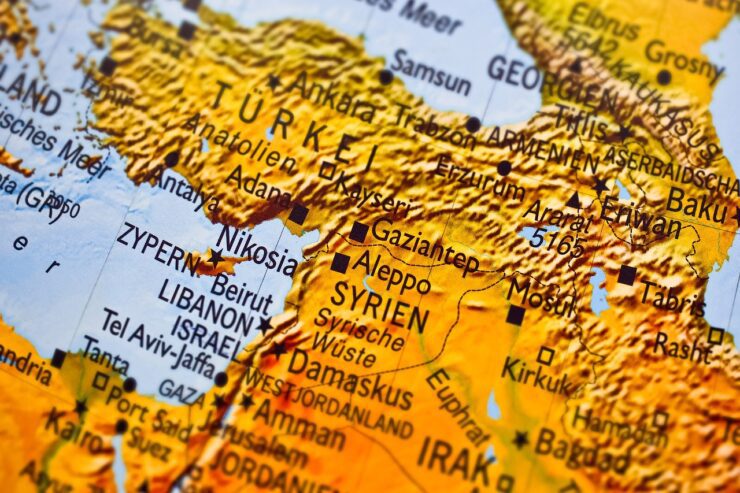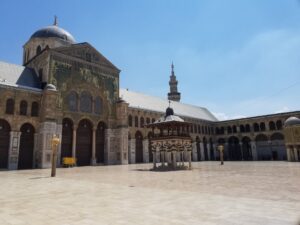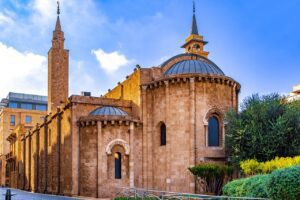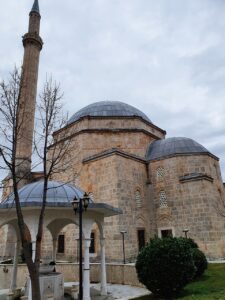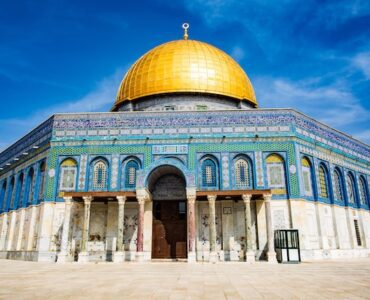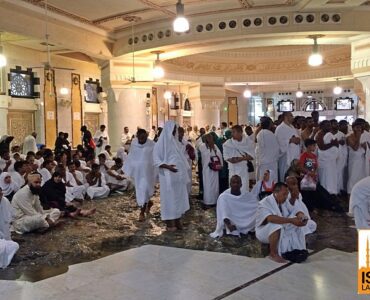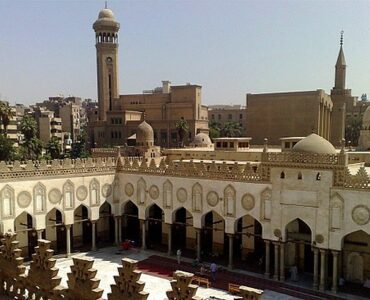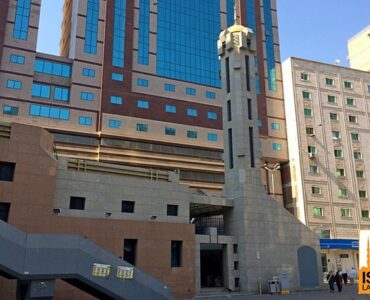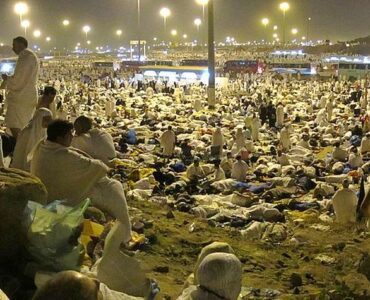Syria’s enchanting landscapes are graced by a magnificent array of mosques, each reflecting the country’s profound historical, cultural, and religious diversity.
From the bustling markets of Damascus to the ancient alleys of Aleppo, these mosques stand as architectural marvels, reflecting the nation’s intricate past and enduring devotion.
Each mosque tells a unique story, carrying the whispers of worshippers and the echoes of history. Read this guide on Mosques in Syria and as we explore ten remarkable mosques that have etched their beauty into Syria’s tapestry.
How Many Mosques Are There in Syria?
Syria is a land steeped in religious heritage, with mosques serving as essential hubs for communal worship and cultural gatherings. While the precise number may vary due to ongoing developments, it’s estimated that there are thousands of mosques across the country.
These mosques, ranging from small neighborhood sanctuaries to grand historical complexes, embody the rich spiritual fabric of Syria and underscore its role as a center of Islamic civilization.
Each mosque contributes to the vibrant mosaic of Syrian life, bridging the past with the present through its architectural and cultural significance.
How Many Muslims Are in Syria?
Syria, a nation at the crossroads of history and culture, has been home to a predominantly Muslim population for centuries.
As of the latest available data, approximately 87% of Syrians identify as Muslims. This religious composition has significantly influenced the country’s customs, traditions, and societal norms.
Umayyad Mosque in Aleppo (the Great Mosque of Damascus)
The Umayyad Mosque in Aleppo is an luminous gems within Syria’s architectural crown, each encapsulating its own unique narrative.
Umayyad Mosque, Aleppo: Standing proudly in Aleppo, the Umayyad Mosque, also known as the Great Mosque of Damascus, is a remarkable synthesis of architectural styles spanning centuries.
Its towering minaret, an emblem of medieval Islamic architecture, graces the city’s skyline. Within its sacred confines lies a rich history that mirrors the city’s own evolution, from the Umayyad era to Ottoman influences.
The mosque has weathered the ravages of time and conflict, remaining a beacon of resilience and a testament to Aleppo’s enduring spirit.
Through it’s architectural elegance and historical resonance, encapsulate the essence of Syria’s cultural and spiritual tapestry, offering a glimpse into the profound connections between faith, heritage, and identity.
Largest Mosque in Syria
The Umayyad Mosque in Damascus claims the title of the largest mosque in Syria. Its grandeur and historical significance have made it a symbol of Islamic architecture and cultural heritage.
Interior of Umayyad Mosque
Step inside the Umayyad Mosque to witness a breathtaking blend of intricate design, ancient calligraphy, and serene ambiance—a sacred space that echoes centuries of devotion.
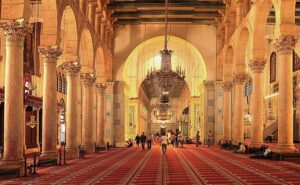

Minaret of Umayyad Mosque
The mosque’s towering minaret punctuates the skyline, a marvel of architecture dating back to 727 CE. Its elegant form and historical resonance continue to inspire.
Mosaics of Umayyad Mosque
Adorned with vibrant mosaics, the Umayyad Mosque narrates stories of faith and artistry. These meticulously crafted designs reflect a rich cultural legacy and aesthetic prowess.
Sayyidah Zaynab Mosque
The Sayyidah Zaynab Mosque, nestled in the heart of Damascus, is a revered site for Shiite Muslims. Its history traces back to the Umayyad period, gaining prominence as a place of spiritual solace.
The mosque’s architecture marries traditional and contemporary elements, with its iconic blue dome catching the eye.
- Address: Sayyidah Zaynab, Damascus.
- Capacity: Accommodates thousands of worshippers.
- It remains a mosque, embodying the essence of Shiite devotion.
- Opening hours vary with prayer times.
- No entry fee is required, as it’s open to all.
- Images of the mosque depict its majesty, attracting visitors worldwide.
- The mosque’s origins date back to the Umayyad era, solidifying its historical significance in the tapestry of Damascus.
Sayyidah Ruqayya Mosque
The Sayyidah Ruqayya Mosque, an emblem of reverence for Shiite Muslims, resides in Damascus. With origins dating back centuries, it holds deep spiritual importance. Its intricate architecture and serene ambiance invite reflection.
- Location: Sayyidah Ruqayya, Damascus.
- Capacity: A sanctuary for numerous worshippers.
- It continues to serve as a mosque, cherishing its Shiite heritage.
- Visiting hours are subject to prayer times.
- No admission fee is enforced.
- Images showcase the mosque’s grandeur.
- The mosque stands as a testament to Syria’s rich religious history.
Al-Omari Mosque
The Al-Omari Mosque, situated in Daraa, stands as a tribute to Islam’s legacy. Steeped in history, it has witnessed epochs of change. Its architectural brilliance reflects a blend of styles.
- Address: Al-Omari Mosque, Daraa.
- A mosque since its inception, it retains its sacred purpose.
- Visiting hours are tailored around prayer schedules.
- Entry is free of charge.
- Images capture the mosque’s timeless allure.
- The mosque’s foundation signifies the roots of faith and community.
Sulaymaniyya Takiyya Mosque
The Sulaymaniyya Takiyya Mosque, located in Aleppo, is a testament to Ottoman architectural ingenuity. Built during the rule of Sultan Suleiman the Magnificent, it combines mosque and takiyya (Sufi lodge) elements. Its intricate façade and meticulous tilework mirror Ottoman aesthetics.
- Address: Sulaymaniyya Takiyya, Aleppo.
- Capacity: Welcomes a sizable congregation.
- It remains a mosque, embodying Aleppo’s spiritual diversity.
- Visiting hours vary.
- No entry fee is imposed, making it accessible to all.
- Pictures capture the mosque’s captivating details.
- Since its completion in 1557, the mosque has been a beacon of faith and artistic brilliance.
Nabi Habeel Mosque
The Nabi Habeel Mosque, found in Aleppo, holds religious significance for Muslims and Christians alike.
Tradition attributes it to Abel’s burial site. Its simple yet powerful design reflects its historical depth.
- Location: Nabi Habeel, Aleppo.
- The mosque preserves its original function, unifying diverse communities.
- Visiting hours align with prayers.
- No entry fee is mandated, promoting inclusivity.
- Images capture the mosque’s serene atmosphere.
- With origins rooted in shared reverence, the mosque bridges religious divides.
Sinan Pasha Mosque
The Sinan Pasha Mosque, situated in Damascus, stands as a testament to Ottoman elegance.
Designed by renowned architect Mimar Sinan, it showcases intricate details and harmonious proportions.
- Address: Sinan Pasha, Damascus.
- Capacity: Provides a space for worshippers to gather.
- A mosque since its inception, it commemorates Ottoman rule.
- Visiting hours correspond to prayer times.
- Entry is free, fostering accessibility.
- Images exhibit the mosque’s architectural finesse.
- Constructed in 1590, the mosque is an enduring emblem of Ottoman influence.
Aqsab Mosque
The Aqsab Mosque, located in Damascus, is a tranquil haven reflecting early Islamic architecture.
Built during the Umayyad era, its historical significance is palpable.
- Location: Aqsab Mosque, Damascus.
- Capacity: Welcomes worshippers and history enthusiasts alike.
- It remains a mosque, echoing the Umayyad legacy.
- Visiting hours coincide with prayers.
- No entry fee is enforced.
- Images showcase the mosque’s timeless charm.
- Since its establishment in the 8th century, the mosque whispers tales of an illustrious past.
Nur al-Din Mosque
The Nur al-Din Mosque, a gem of Aleppo’s skyline, honors the legacy of Nur al-Din Zangi, a medieval ruler.
Its construction in the 12th century marked a shift towards intricate architectural details.
- Address: Nur al-Din Mosque, Aleppo.
- Capacity: Provides a sacred space for worshippers.
- It stands as a mosque, embodying historical continuity.
- Visiting hours align with prayers.
- No entry fee is charged.
- Images capture the mosque’s eternal beauty.
- Since its establishment, the mosque has borne witness to Aleppo’s evolution, reflecting a blend of faith and history.
Khalid Ibn Al-Walid Mosque
The Khalid Ibn Al-Walid Mosque in Homs pays homage to the celebrated Muslim commander Khalid Ibn Al-Walid.
Its contemporary design embraces modern elements while preserving a deep reverence for his legacy.
- Location: Khalid Ibn Al-Walid Mosque, Homs.
- Capacity: Offers a haven for worshippers.
- It continues to function as a mosque, commemorating his achievements.
- Visiting hours accommodate daily prayers.
- No entrance fee is enforced.
- Pictures highlight the mosque’s distinctive design.
- This mosque, established in the 20th century, stands as a tribute to a revered military strategist.
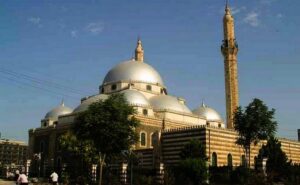

Other Islamic Landmarks in Syria
- Minaret of Prophet Isa (AS): Rising from the enchanting landscapes, the Minaret of Prophet Isa (AS) holds an air of mystery. Linked to the prophet Jesus (AS), its presence speaks to the shared reverence between Islam and Christianity, embodying interfaith connections.
- Shrine of Yahya (AS): The Shrine of Yahya (AS), also known as the Shrine of John the Baptist, stands as a sacred site echoing stories of devotion. This revered location is a testament to the respect Islamic tradition holds for Yahya (AS) and his role in connecting faiths.
- Tomb of Bilal (AS): The Tomb of Bilal (AS), a companion of Prophet Muhammad (peace be upon him), is a cornerstone of Syria’s Islamic heritage. It serves as a tribute to Bilal’s unwavering commitment to the faith, symbolizing the values of equality and justice within Islam.
Summary – Mosques in Syria
We hope you enjoyed reading our guide on ‘Mosques in Syria’. To sum it up, Syria’s mosques embody a fusion of faith, history, and architecture.
From the grandeur of the Umayyad Mosque in Damascus to the intimate sanctuaries of Aleppo, these places of worship narrate tales of devotion and resilience.
Each minaret, mosaic, and dome carries the legacy of a nation woven with threads of faith.

